

16 Websites to Teach and Learn Vocabulary. There are now several web tools that are really great in teaching vocabulary and that you can use with your students in the classroom.
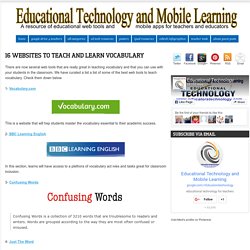
We have curated a list a list of some of the best web tools to teach vocabulary. Check them down below. 1- Vocabulary.com This is a website that will hep students master the vocabulary essential to their academic success. 2- BBC Learning English In this section, learns will have access to a plethora of vocabulary act ivies and tasks great for classroom inclusion. 3- Confusing Words Confusing Words is a collection of 3210 words that are troublesome to readers and writers. 4- Just The Word Just The Word is a cool website that helps students make informed decisions as to the right word selection to use in their writing 5-Lexipedia Lexipedia is an online visual semantic network with dictionary and thesaurus reference functionality 6- Wordnik Wordnik shows definitions from multiple sources, so you can see as many different takes on a word's meaning as possible.
Long Vowel Phonics Game. 1st and 2nd grade Blending worksheets. "Silent E" song. Diphthong Words: OU OW Sounds Game. Decodable passages cvce. 2,000 Most Common English Nouns. The English Alphabet. SpinandSpell.com. Spelling Games. Vocabulary Practice With Rap Your Words. Vocabulary Practice With Rap Your Words Posted on Thu, Sep 15, 2011 I love being able to let popular celebrities inspire my students with a positive educational message, especially the most unlikely ones.
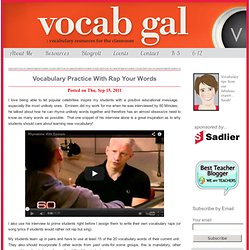
Eminem did my work for me when he was interviewed by 60 Minutes; he talked about how he can rhyme unlikely words together and therefore has an almost obsessive need to know as many words as possible. That one snippet of his interview alone is a great inspiration as to why students should care about learning new vocabulary! I also use his interview to prime students right before I assign them to write their own vocabulary raps (or song lyrics if students would rather not rap but sing). My students team up in pairs and have to use at least 15 of the 20 vocabulary words of their current unit.
The vocabulary words have to be used in context and must make sense; furthermore, the lyrics need to be clean and not cruel. Find Similar or Opposite words at WordHippo. KS2 Literacy. Different types of words can be used to make your writing more interesting and easier to read.
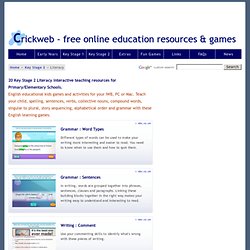
You need to know when to use them and how to spot them. In writing, words are grouped together into phrases, sentences, clauses and paragraphs. Linking these building blocks together in the right way makes your writing easy to understand and interesting to read. Use your commenting skills to identify what's wrong with these pieces of writing. When you are writing non-fiction it's important to use a style of writing that fits the subject.Use your knowledge of non-fiction writing to group the correct titles, text and pictures together. The Look, Say, Cover, Write & Check is a support tool for learning spellings using a trusted multi-sensory approach. This activity helps prove the rules of changing nouns from singular to plural. This is an activity targeted to Year 4 to help with medium frequency words. An updated version of the traditional word guess game. A humurous seaside writing activity.
Tutpup - play, compete, learn. The Idiom Connection. Vocabulary Index. Spelling & Vocabulary Website: SpellingCity. Top 20 Words. Learning English - Today's Phrase.
Blends, Digraphs, and Trigraphs. Consonant blends (also called consonant clusters) are groups of two or three consonants in words that makes a distinct consonant sound, such as "bl" or "spl.
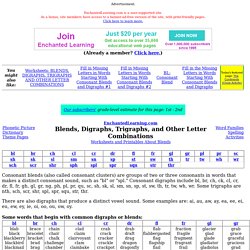
" Consonant digraphs include bl, br, ch, ck, cl, cr, dr, fl, fr, gh, gl, gr, ng, ph, pl, pr, qu, sc, sh, sk, sl, sm, sn, sp, st, sw, th, tr, tw, wh, wr. Some trigraphs are nth, sch, scr, shr, spl, spr, squ, str, thr. There are also digraphs that produce a distinct vowel sound. Some examples are: ai, au, aw, ay, ea, ee, ei, eu, ew, ey, ie, oi, oo, ou, ow, oy. Some words that begin with common digraphs or blends: Some words that begin with common trigraphs: Books to Print: Vocabulary worksheets. Actions Business English Clothes Colours Communication worksheets Countries and nationalities Culture and traditions Describing people Education English for Specific Purposes ESP Environment and nature Face and body Family Flashcards Food Friendship General vocabulary Greetings Health Hobbies Holidays and traditions Idioms Jobs/occupations/professions likes and dislikes Meaning Music Numbers Peace and solidarity People Personal information Phonics Picture composition Places School Science Seasons Sports Technologies The age The alphabet The animals The city The house The transports The weather Time Travelling Teach Children to Read with Phonics, Worksheets, Games, Videos, Books These are among the best phonics worksheets, games, videos and flash cards you will find online.
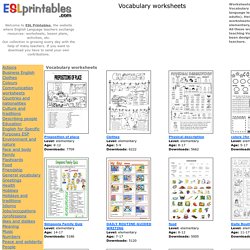
The has everything you need to help a child learn to read through phonics: decodable stories, listening exercises, you name it. Visit this page now! Vocabulary Index.